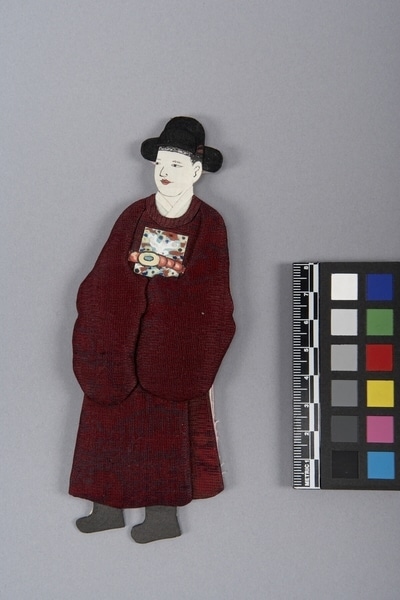Doll Item Number: Ed1.144 from the MOA: University of British Columbia

Description
Figure representing a person on a flat backing of white paper. Front view is depicted of the figure which is made of cloth lightly padded to give a three-dimensional effect having each portion made of a separate piece of cloth with painted details. Face is made of white silk. Wearing a rounded black hat with round projections at the lower back, an ankle-length robe with full sleeves in black silk gauze over red fabric, and a belt under the arms of paper painted red, yellow, green, and black, over a square panel of the same material, and colours. Boots are made of black paper. Two pieces of white flannel hemmed with light red-pink silk are sewn to the paper backing.
History Of Use
Figure represents a (male) official of the Yi Dynasty (1392-1910), probably from the later years of that dynasty. Red colour of robe, black silk hat with projecting "ears", square badges on front and back of robe, and details of jade-trimmed belt, all are insignia of rank. Examinations on Confusian subjects were held to select men for government positions. Only upper class men could sit for the civil service examinations, although those for the services were less restricted. Such figures were made during the time when Korea was first open to the outside world (after the mid 1890s), probably as gifts to present to missionaries or other visitors from foreign countries. Flat dolls like these were very popular during the period 1910-20. Before that time, shamans made dolls that they sold to their clients, as images of those the clients wanted to exorcise. Simple dolls were made of straw for children to play with. After Korea opened, people began to see dolls as artistic objects. They were made in workshops by masters, using authentic fabrics whenever possible, as their purpose was to introduce foreigners to Korean society.
Iconographic Meaning
The round-neck robe, rank badge, hat, and boots indicate that this represents an official. The colour of the robe indicates that the official is of higher rank.
Specific Techniques
The clothing was stitched around the edge and then a layer was added inside the clothing. Each section was separately applied and pasted in place.
Narrative
Collected by J. H. Morris while he was chief engineer for Seoul Railway, Korea.
Item History
- Made in Korea during 1910
- Collected between 1910 and 1939
- Owned by Marion Stephan before August 1964
- Received from Marion Stephan (Donor) during August 1964
What
- Name
- Doll
- Identification Number
- Ed1.144
- Type of Item
- doll
- Material
- cotton fibre, rayon fibre, paint, paper, silk fibre and paste adhesive
- Manufacturing Technique
- pasted, spun, woven, cut, painted and sewn
- Overall
- height 15.7 cm, width 5.9 cm, depth 0.7 cm
Who
- Culture
- Korean
- Previous Owner
- Marion Stephan
- Received from
- Marion Stephan (Donor)
Where
- Holding Institution
- MOA: University of British Columbia
- Made in
- Korea
When
- Creation Date
- during 1910
- Collection Date
- between 1910 and 1939
- Ownership Date
- before August 1964
- Acquisition Date
- during August 1964
Other
- Condition
- good
- Current Location
- Case 77
- Accession Number
- 0113/0047